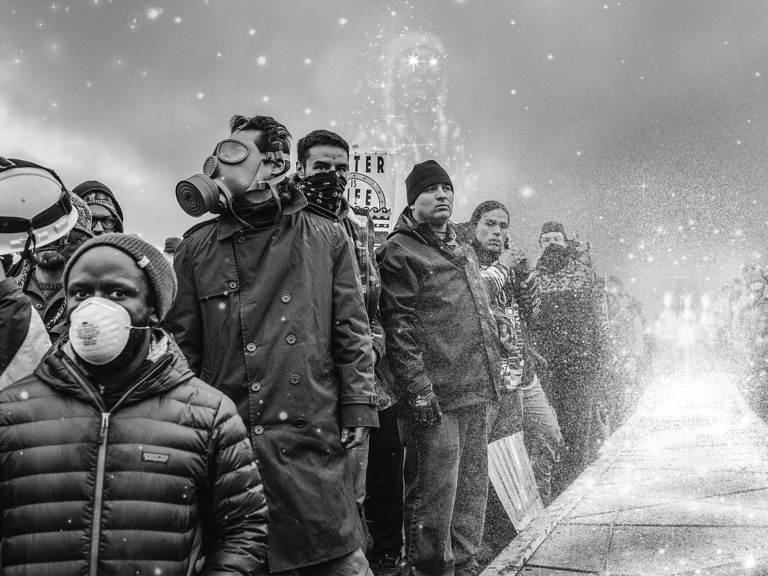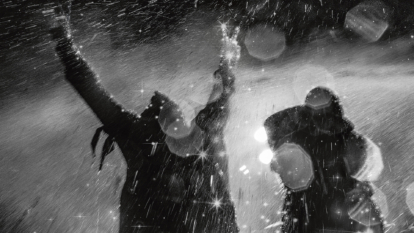Protecting the Right to Protest
All illustrated photos by Josué Rivas. Josué layers illustrations over his film photography to reveal what the eye cannot see in a photographic image alone.
Nearly 10 years ago, I got a call from an old friend, an Indigenous environmental leader stationed at the Standing Rock protests against the Dakota Access Pipeline (DAPL). Up at the Standing Rock camp, they needed some support: A solar generator to charge phones for communications and media coverage and a few experts to train growing groups of protestors in the principles of nonviolent direct action and de-escalation. At the time, he was observing increased aggression from hired security against protestors, so he wanted help to keep the protests peaceful.
I mobilized my colleagues at Greenpeace USA swiftly and without hesitation. Shortly, The Rolling Sunlight (our mobile solar truck) and a few trainers were on the road.
This is not how you might think one of the largest lawsuits in North Dakota’s history would begin. But these small gestures of support are why Energy Transfer, the oil company behind DAPL, is suing Greenpeace for $300 million. Our work to aid the Standing Rock protests, they falsely claim, cost their company hundreds of million in profits.
Energy Transfer does not really want Greenpeace’s money—though sure, it could bankroll some bonuses. Rather, the CEO of Energy Transfer has said he wants to end funding for Greenpeace and “send a message” that our actions of solidarity were “unlawful” and won’t “be tolerated in the United States.”
Unfortunately, Energy Transfer isn’t acting in isolation. In the past few years, corporate interests have been working extra hard to erode the right to do what activists do when they come together to address a problem: speak out, organize, collaborate, raise funds, and when other avenues of democratic participation fail to produce results, put their bodies on the line through acts of nonviolent civil disobedience.
Rather than embrace the transition to clean, renewable energy, fossil fuel interests and their allies in government aim to weaken the powerful tool of protest so they can continue to frack, drill and mine unchallenged, without addressing the human and ecological cost of continued extraction.
The systemic attack on peaceful protest takes many forms, including Strategic Lawsuits Against Public Participation (SLAPPs) and anti-protest legislation.
SLAPPs are a kind of corporate legal bullying. The meritless lawsuits aren’t necessarily designed to win in court but aim to intimidate, distract, bankrupt, exhaust and silence critics. These suits can be waged against large, well-known organizations like Greenpeace, small local community groups, media platforms and also individuals. For example, in West Virginia, a community organizer I know, Alex McKinnon (a pseudonym), was one of dozens of activists sued by a group of fossil fuel corporations for protesting a 300-mile multibillion-dollar pipeline set to cut through the Appalachian Trail.
Currently, 33 US states have anti-SLAPP legislation, but even with these laws, corporations that SLAPP activists get away with inconsequential fines if anything; whereas activists have years of their lives burdened with bogus but expensive legal proceedings. Often, SLAPP defendants can’t even discuss details with friends and allies, for fear of pulling them into the lawsuit.
“It’s isolating, and it just drags on and on,” Alex told me, whose case is still set to head to trial.
Another measure to silence protests are laws that criminalize constitutionally protected activity or increase penalties for already illegal activities, such as turning trespassing into a felony or adding domestic terrorism charges to the complaint. Since 2017, 44 US states have adopted anti-protest laws (commonly known as Critical Infrastructure Bills), with more than two dozen additional bills pending. These laws, which have been used to target activists like Alex, label fossil fuel and other industrial property as “critical infrastructure” to justify severe crackdowns on protesters.
Indigenous land defenders are especially vulnerable to criminalization of protest. Nick Tilsen, a leader in Standing Rock protests, recently faced the threat of 17 years in prison after leading a peaceful protest demanding the return of illegally seized Lakota territory known as the Black Hills—to restore Native rights and protect the lands from further extraction.

Nick Tilsen (center left) and other water protectors cross a handcrafted bridge to Turtle Island, a sacred site and burial ground for the Standing Rock Sioux.
Many fossil fuel corporations are launching SLAPP suits while lobbying for anti-protest legislation. A 2023 Greenpeace study found that about 75 percent (86 out of 116) of SLAPPs and other forms of legal harassment since 2010 were filed by corporations that helped draft or pass these anti-protest criminal laws. Big Oil and Gas is covering all its bases to try to silence anyone raising the alarm, which is exactly what our movements need to be doing.
With such a large-scale attack on protest, we must ask ourselves why corporate interests and their allies in government are so threatened by our right to speak up. To me, the answer is clear. Dissent is currency for the powerless. It can’t be bought or sold, and it is never stagnant—it can only grow or be squashed. The rich and powerful have never had such a strong hold on our democracy. Their incentives to eradicate protest, therefore, have never been so resonant.
Communities most excluded from decision-making processes know this truth the best. For them, protest is often the only avenue of democratic participation that’s readily available. This is in part why civil disobedience—a tactic that oftentimes involves breaking the law—has helped cement monumental human rights wins for social movements across the world, led by the likes of Martin Luther King Jr., Rosa Parks, and Gandhi.
Protest, whether with words or one’s body, also threatens powerful interests because of its ability to empower individuals and marginalized groups. And because state-sanctioned violence against protestors unfairly targets Black, Indigenous and other people of color, acts of solidarity, like Greenpeace’s support for the Standing Rock protests, become even more important.
“For those of us concerned about the climate crisis, daily life can feel like cognitive dissonance,” activist and actor Jane Fonda told me recently. “It’s when I speak out, when I engage in civil disobedience, when I put my body on the line that I feel like my body and my values are fully aligned. And from that place of alignment, I can better advocate for the change we urgently need.”
I’ve felt that power over my 30-year-long commitment to environmental activism and protest, including the dozens of times that I engaged in civil disobedience. And I know I’ll feel that power when I take the witness stand to defend my decision to use Greenpeace’s resources to stand in solidarity with Indigenous activists’ brave acts of peaceful environmental protest.
I’ll walk into that small courtroom in Bismarck, North Dakota, with my head high, look the jury in the eyes and tell them the truth. Peaceful protest is under attack. Without it, the planet we all depend on doesn’t stand a chance.
This article was first published in Patagonia’s Fall 2024 Journal and was updated on February 24, 2025, to reflect current events.
Listen to the story

